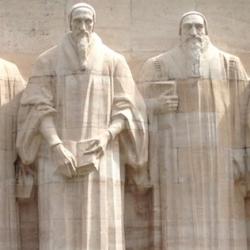Paedocommunion not only implies that the church is the new Israel, but that the church is the new humanity. To say the one is to say the other, for Israel was chosen from among the nations to be Yahweh’s instrument to reverse the sin at Babel, the sin of the sons of God, the sin of Cain, and the sin of Adam. That reversal only takes place through the faithfulness of the true Israel, Jesus Christ. In Christ, we are called to the same calling as Israel: to live before the Creator as all mankind was created to live before Him. By maintaining continuity between the rites of Israel and the rites of the church, paedocommunion declares decisively that the church is now the heir to this calling.
The notion that the church is the new humanity rests on fundamental Christological affirmations. In His resurrection Jesus was constituted the “new man,” the new Adam (1 Corinthians 15:35-49), and this implies that He is Head of a renewed human race. The same point can be established by a more directly ecclesiological argument. According to Ephesians 2:11-22, the purpose of the cross was to destroy the dividing wall that separated Jew and Gentile, and so to constitute Jew and Gentile into one new humanity. Saying that the church is the new humanity does not mean that every human being is now a member of Christ or His church. But it does mean that nothing human is alien to the church; and, positively, that the life of the church as the community of the New Man encompasses the life of humanity itself. The church is not a “religious” organization in the restricted modern sense; it is a people that, through the power of the Spirit of Jesus, have been converted to and are being discipled in a new way of being human.
Opponents of paedocommunion might well agree with the arguments of the preceding paragraph, but this raises again my initial claim that the rites of the church express the character of the community that the church is. Only by including children among the table-fellows of Christ can the church display with consistency that she is the new human race. A happy thought experiment will help make the point. Suppose that tomorrow morning we woke up to find every living man and woman, teenager and senior citizen, toddler and infant converted by the Spirit of God, so that we suddenly lived in a world where the human race on earth was made up only of eternally elect. Suppose too that we were given an incontestable sign that this miracle had occurred, so that there would be no doubt that the human race was thoroughly Christianized.
Under these theoretical circumstances, would the church be coextensive with the now-converted human race? Should Baptists insist on remaining Baptist, the answer would be no. Even under these circumstances, there would be many converted infants and toddlers who could not make what Baptists normally recognize as a credible profession of faith. So, the converted human race would be divided between those who have the capacity to make a profession of faith and those who did not have that capacity. Only the former would be baptized and admitted to the Supper. Even if the whole human race were saved, there would still be a distinction between “church” and “world.” Baptists thus imply by their refusal to baptize infants that the church is not, even theoretically, coextensive with the human race. Believer’s baptism implies that the church is not the new humanity.
I am sure that many Baptists confess that the church is the new humanity, but there is a disjunction between confession and sacramental practice. Believer’s baptism says of the church that it is not the new humanity, which is also a statement about the character of the gospel. Believer’s baptism says of Christ that He is no new Adam, but at best a new Abraham or Moses—the head of a chosen people, but not the head of a new race.
Paedobaptists claim otherwise. If everyone in the world were converted, or if even all the parents of young children were converted, then all would be immediately incorporated into the church by baptism, so that the church would be coextensive with the converted human race. For paedo-baptists, the church by definition is the new humanity, and it includes, as the human race itself does, all sorts and conditions of men, all ages and stages of life, all levels of ability and degrees of faith. The church is not an elite religious group for those who can make mature and credible professions. In Christ, the church is the “one new man.” For the paedobaptist, the only thing that excludes a human being from the church is the sin of unbelief. Age, mental or linguistic capacities, and life experience are simply not factors.
But paedobaptist opponents of paedocommunion are inconsistent on this point, and it is an inconsistency that has damaged the witness of paedobaptist churches more deeply than we can fathom. With their rite of baptism, they proclaim that the church is the new human race, theoretically coextensive with mankind as a whole. By making doctrinal knowledge, conversion experience, or some other rite of passage an additional requirement for admission to the Lord’s table, however, they take away with bread and wine what they give with water.
On the one hand, they claim that children are initiated into the covenant community, but on the other hand they say that “knowledge” and “spiritual maturity” are required for participation in the meal of the community, the meal that expresses the unity of the community. On the one hand, they say that children of Israel were admitted to Israel by circumcision, but on the other hand, many claim that they were denied the Passover, which was “the sacrament of communion, life and growth.” A moment’s reflection will reveal the incoherence here: Children are inducted into the church, but denied one means for growth; they are expected to become mature, but denied one of the key means for attaining maturity.
But the incoherence of the position is not merely practical. It is ecclesiological and soteriological, Christological and cultural. At the font, paedobaptist opponents of paedocommunion say that grace restores nature; at the table, they say that grace transcends nature. At the font, they say that God’s grace can work to make an infant a saved infant; at the table, they say that grace only begins to restore human life after one reaches a certain level of maturity. At the font, they say that the gospel announces the restoration of the human race; at the table, they say that the gospel invites the mature into fellowship with God. At the font, they say that the church is the new humanity; at the table, they say that the church is a religious community for those who can profess faith. At the font, they say that Jesus is the new Adam; at the table, that Jesus is “merely”the new Abraham. At the font, they radically challenge the modern confinement of religion to a circumscribed sphere of life; at the table, they bow to modern assumptions.
In response, an opponent of paedocommunion might say that the infants in the thought experiment are members of the church, but not communing members. They are in covenant, but do not participate in this one rite of the covenant. This divides the question: On the one hand, it affirms that the church is the new humanity, but on the other hand, it denies that participation in the church’s meal is a necessary privilege of inclusion in that new humanity. I find this inconsistent, but it does reveal an underlying assumption that I must defend, namely, that inclusion in the covenant meal is a necessary privilege of covenant membership. I’ll address that in the last installment of this essay.
This essay was first published in Credenda/Agenda, 18.1.













